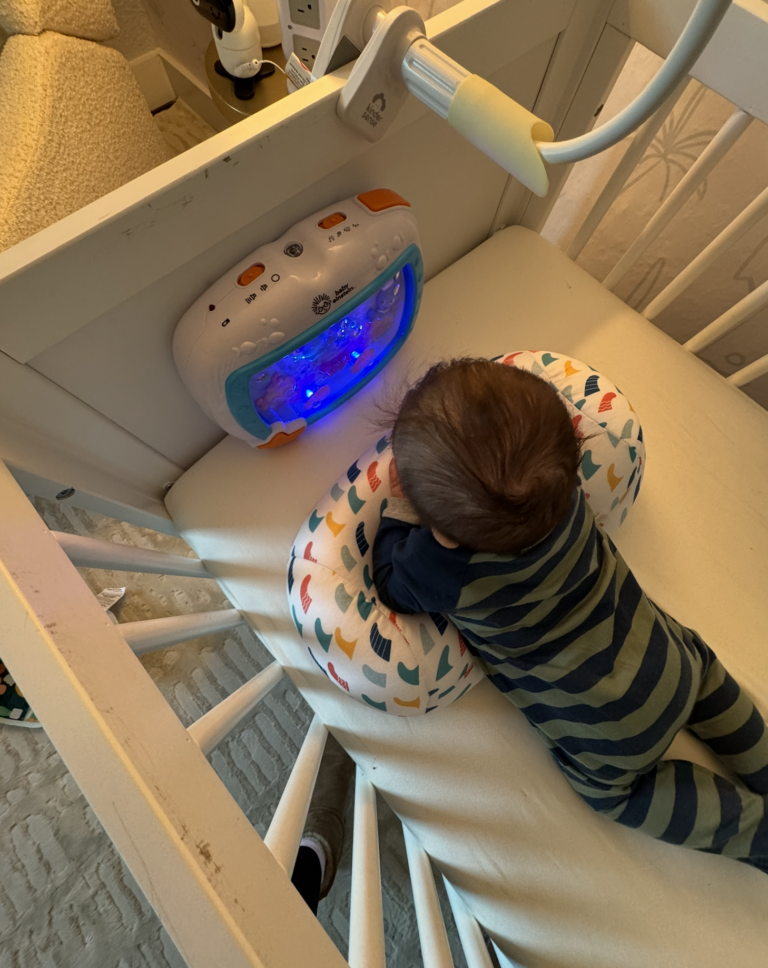The Easiest Newborn Schedule Week by Week
Becoming a brand new mom with a newborn means opening the door to a brand new world of all things baby. Starting to work on a schedule of wake-windows, feedings and naps makes the newborn stage a lot easier. In those first few weeks, newborns run the show on their own schedule. But there are lots of things that mommy and daddy can do to make the process of building a schedule and routine a lot easier for you and your baby.
This is the easiest newborn schedule that I would recommend for any new mom.

Newborn Schedule Weeks 1-2
The first few weeks of your babies’ life will mostly be spent eating and sleeping. In the first week your baby will likely sleep 17-18 hours in a 24 hour period. Your newborn will definitely let you know when they are hungry. Newborn babies let you know they are hungry by their “cues” which are some signs they can exhibit that let you know they are hungry before they are screaming their heads off.
Common Newborn Hunger Cues:
Licking their lips
Turning their head and suckling like they are looking for the nipple
Suckling on things
Putting their hands in their mouth
Once they are fussing and crying, your baby is already in the later stages of hunger. Feeding them before they get to the later stages by noticing their cues will make feeding easier for the both of you. It’s like eating when you feel like you are going to be hungry soon rather than half-past hangry!
******Tips
Also, getting your baby to stay awake for their feedings will help develop their schedule for better sleep. There are many ways to do this. During the day, try unswaddling them and stroking their cheek or their feet. Continuously burp your baby throughout their feedings to keep them moving and alert.
Here is an example of a schedule for the first week:
8:00 am Awake, feed, diaper, play
8:45 am Nap #1
10:15 am Awake, feed, diaper, and play
11:00 am Nap #2
12:30 pm Awake, feed, diaper, and play
1:30 pm Nap #3
2:45 pm Awake, feed, diaper, and play
3:30 pm Nap #4
5:15 pm Awake, feed, diaper, and play
6:00 pm Nap #5
7:00 pm Awake, feed, diaper and play
8:30 pm Last nap of the day
9:00 pm Awake, bath, feed, diaper, pajamas
10:30 pm Book and lights out for everyone!
Newborn Schedule
Week 3
By week 3, your baby is beginning to develop their senses and become more aware of their surroundings. They might also be sleeping for longer stretches of time and they will be eating more.
For some parents, they are beginning to notice that their babies are waking and becoming more alert at night. If you are noticing that your baby is taking very long naps during the day and awake every 2 hours at night, your baby likely has day/night confusion. This day/night confusion is very common for newborns and there are definitely ways to handle it. Here is how to reverse that and start getting better sleep.
When your baby wakes up in the morning, treat their awake times like they are up for the day. Keep the lights on and curtains open, play music that is not too loud or overstimulating, and take them around the house while you are doing chores or even outside on a short walk. Also, do anything you can to create a bright, energy-filled environment and save the dark and quiet for nighttime.
When your baby goes down for naps during the day, put them to sleep but don’t make it dark. Keep the blinds open and don’t tiptoe around the house. My best tip when my son was born was to continue my day like normal when he was napping during the day so he could sleep through anything.
Also, I would run the vacuum, do the dishes, listen to music, etc. And now he can sleep through anything.
During your babies’ wake windows during the day, try to do activities that are more stimulating like tummy time, reading, playing with them, and peek-a-boo.
Once it’s bedtime, start establishing a bedtime routine. At 3 weeks, this could be a bath, baby massage, book, feed and time for bed. Babies thrive off of a routine even at 3 weeks old. They will begin to know that it is time for bed and the stimulation of everything involved in the routine will tire them out and get them ready for a long stretch of sleep. We started our bedtime routine at just a few weeks old and we are still doing a variation of it 3 years later!
Make sure that when you are putting them down for bed at night, it is in a dark room where they are comfortable and swaddled with white noise or a sound machine.
Here is an example of a schedule for your 3 weeks old newborn:
8:00 am Awake, feed, diaper (opening up blinds, having your coffee outside)
9:00 am Nap #1
10:30 am Awake, feed, diaper (tummy time, household chores, cutting their nails)
11:30 am Nap #2
1:00 pm Awake, feed, diaper (watching you cook/eat lunch, laundry, baby swing)
2:00 pm Nap #3
4:00 pm Awake, feed, diaper (chores, dinner prep, tummy time, playing)
5:00 pm Nap #4
6:30 pm Awake, feed, diaper (family dinner, house reset, play)
7:30 pm Nap #5
9:00 pm Awake, feed, diaper, bedtime routine (dark room, swaddle, sound machine)
10:00 pm Baby goes to sleep for the night
However, keep in mind that your baby will continue to need to be fed on demand at this stage and that this schedule is just a sample that you baby will likely deviate from. What you can keep in mind at this stage is feeding them when they are hungry and putting them down for a nap after being awake for 1 hour.
Newborn Schedule Week 4-5
You made it through your first month! Congratulations mama!
Every new stage in your newborn/babies’ life comes with exciting changes as well as new challenges to overcome. While you may be excited that your baby is hitting new milestones, becoming more alert and aware of their surroundings, you may also notice that this is causing a new hurdle with sleep as well.
With all of these new developmental milestones and changes, this can cause your baby to be fussier and disrupt their sleep. Because of this, it might take them longer to go down for their naps or bedtime. If you have not experienced this yet, there is also a period with babies known as the “witching hour.”
This time is typically between 5pm-bedtime when your baby can be extremely fussy. Although, don’t worry this is normal.
During the witching hour, here are some things you can try to soothe your baby:
- Cluster Feed
- Baby-wearing or swaddling
- Warm bath and baby massage
- Playing calm music (but not lullaby/bedtime sound machine sleep sounds)
- Using your baby swing/bouncer
Around 4-5 weeks, you may begin to notice your baby has developed their startle reflex and waking up early from their naps. All babies develop their startle reflex that causes them to jolt and wake up suddenly. This reflex does eventually go away.
To help with this, try swaddling your baby so that their movements aren’t causing them to wake up during every nap. Some babies prefer to keep their arms by their face. You can get an arms-up swaddle that will still allow your baby to keep their arms up. These were my babies’ favorite swaddles:
However, during these weeks, don’t make the mistake of thinking your baby can stay up for longer periods than they should. Make sure that their wake windows are age-appropriate and this will help them sleep longer and better at night as well as go down easier for naps and they are not over-tired.
In addition to this, if you put your baby down for a nap when they first start showing signs of tiredness, your baby will actually sleep longer. You can see common sleep cues that will let you know your baby is tired.
Common sleep cues:
- Rubbing their eyes
- Yawning
- Fussing (make sure their diaper is changed and they are not hungry)
- Zoning out or daydreaming
Newborn Schedule Week 6
At week 6, many parents start feeling like they are really getting the hang of being parents. Your baby is likely sleeping longer stretches at night and you are hopefully mastering daytime naps. Six weeks is a great time to start getting into a real schedule and nailing down habits and routines. This is also a good time to introduce a dream feed into your routine so you and baby can get a longer stretch of sleep.
Many moms will introduce a “dream feed” at 10 or 11 pm which is where you will lightly wake the baby up just enough to feed at night. The goal of a dream feed is to make your baby full so that they can get one long stretch of sleep and so you can too.
Here is an example of a schedule for your 6 week old newborn:
8:00 am Awake, feed, diaper, play, tummy time, go outside
9:15 am Nap #1
11:15 am Awake, feed, diaper, play, chores with mom
12:30 pm Nap #2
2:30 pm Awake, feed, diaper, short walk, tummy time
3:45 pm Nap #3
5:00 pm Awake, feed, diaper, help mom with dinner and chores
6:15 pm Nap #4
8:00 pm Awake, feed, diaper, nighttime routine, house reset with mom
9:45pm Down for bed
11:00 pm Dream feed
At six weeks, your baby will likely be awake for longer periods of time. They’ll typically want to nap after being awake for an hour and fifteen minutes.




